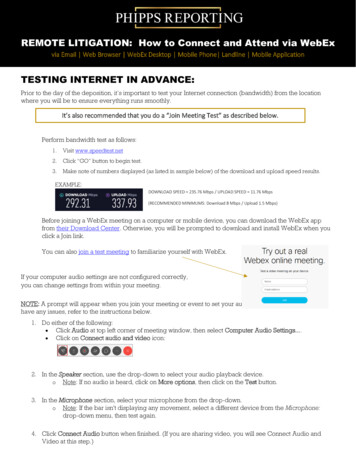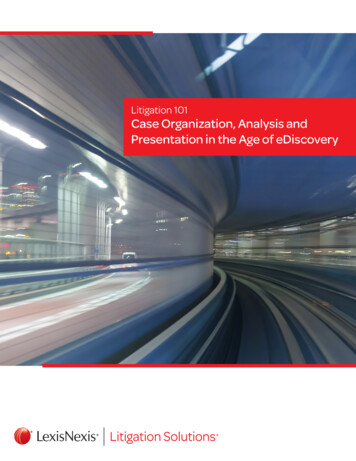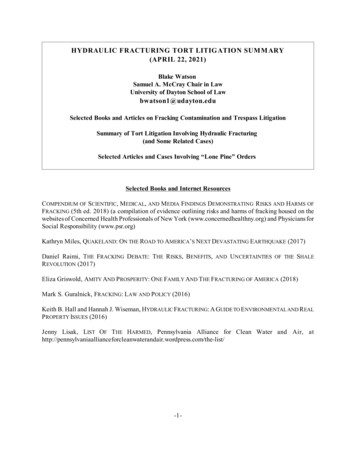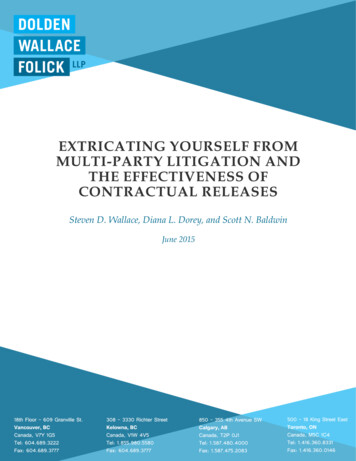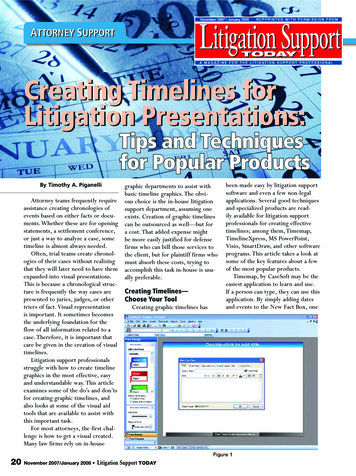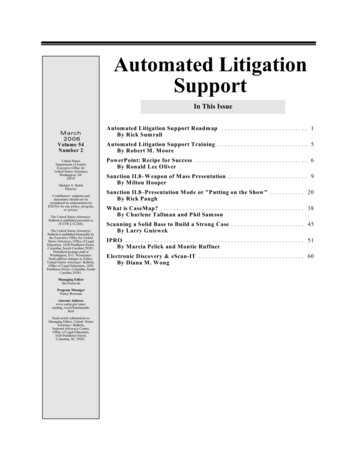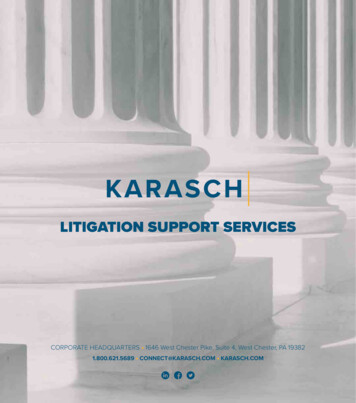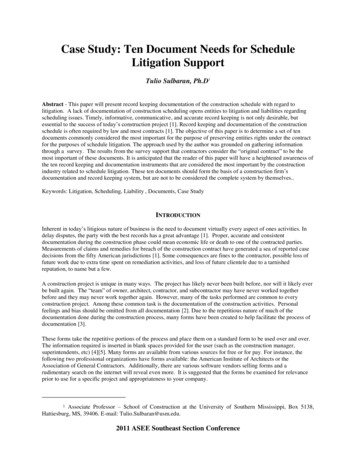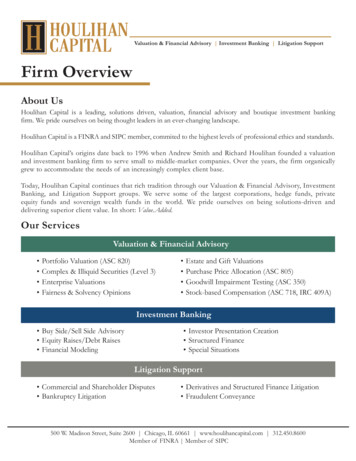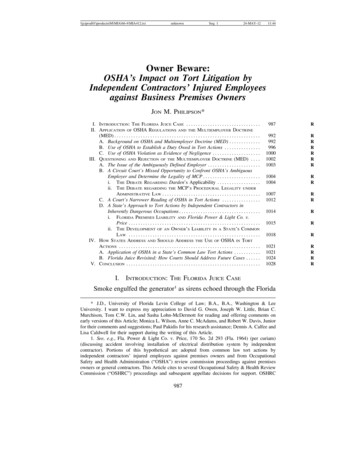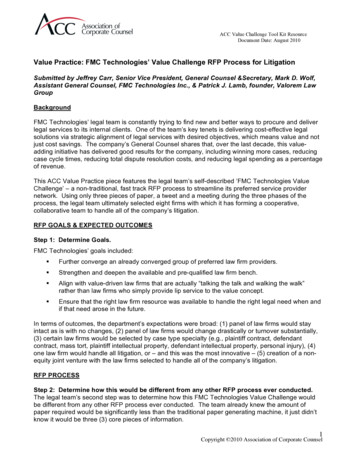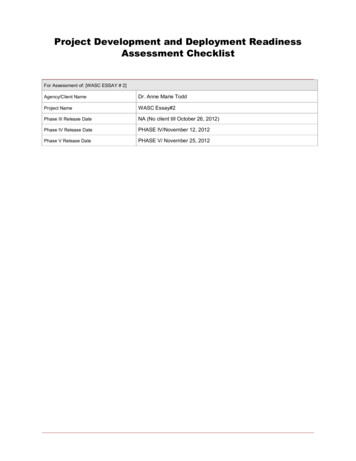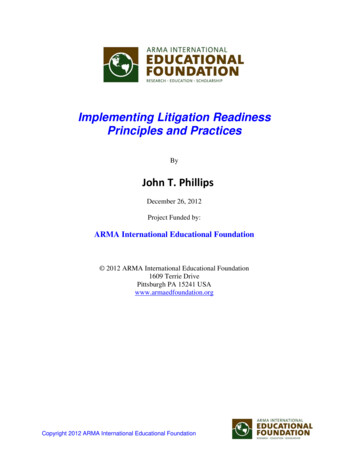
Transcription
Implementing Litigation ReadinessPrinciples and PracticesByJohn T. PhillipsDecember 26, 2012Project Funded by:ARMA International Educational Foundation 2012 ARMA International Educational Foundation1609 Terrie DrivePittsburgh PA 15241 USAwww.armaedfoundation.orgCopyright 2012 ARMA International Educational Foundation
Table of ContentsACKNOWLEDGEMENTS . 4INTRODUCTION . 5RECORDKEEPING AND LITIGATION . 9Litigation and Records Retention . 9RIM Programs and Litigation . 10Placing Litigation Holds on Records . 11GUIDELINES FOR RECORDS PRODUCTION . 13Federal Rules of Civil Procedure . 13The Sedona Conference . 14Electronic Discovery Reference Model . 15Litigation Support Industry . 16Records Production Summary . 17PROFESSIONAL ORGANIZATIONS . 18ARMA International . 18American Bar Association . 19Association of Legal Administrators . 20Association of Certified E‐Discovery Specialists . 20Association of Litigation Support Professionals . 21AIIM International. 21Professional Organizations Summary . 22THE LITIGATION PARTNERSHIP . 23Records Management Before Litigation . 23Law Firm Records Management . 24Copyright 2012 ARMA International Educational Foundation
Client Records Processing . 26LITIGATION PREPAREDNESS OUTSOURCING . 28ESI Outsourcing Grows . 28Legal Process Outsourcing . 29GETTING ORGANIZATIONS READY . 33Litigation Readiness Combines Concepts . 33Need for Business Model Changes . 34RIM Educational Assistance Opportunities. 36Post Litigation Records Management Opportunities . 37SUGGESTED REFERENCES . 38END NOTES . 41Copyright 2012 ARMA International Educational Foundation
ACKNOWLEDGEMENTSThe author would like to thank the ARMA International Educational Foundation, its trustees, andofficers for the opportunity to contribute this investigation to the professional literature ofRecords and Information Management. In addition, the author would like to thank the numerousindividuals who were interviewed to build the base of knowledge presented in this work for theirinsights into the issues and principles that impact litigation readiness and its practitioners.Copyright 2012 ARMA International Educational Foundation
5INTRODUCTIONPreparing for litigation has become a complex and risky endeavor for many organizations todaydue to a changing legal landscape, rising costs for legal services, challenging informationmanagement environments and rapidly changing office technology systems. To be prepared forlitigation requires expertise from experienced legal counsel, capable managers of information,and highly qualified support staff. Together, they must be able to prioritize informationidentification, as well as capture and preserve information thoroughly to respond to demands forlitigation related records. Successful litigation increasingly requires a teaming relationship amonglaw firms, their clients, and information management professionals. These collaboratingindividuals must become clearly communicating partners, assuming new roles andresponsibilities during litigation by adopting new business models with shared responsibilities.Records and Information Management (RIM) professionals in organizations facing litigation mayfind they are working with their organization’s Chief Legal Officer (CLO) to place holds onrecords to prevent their alteration or destruction, produce information for scrutiny in court, orestablish overall Information Governance (IG) policies for the enterprise. Preparing for litigationis often a major part of many RIM professionals’ organizational responsibilities. “Getting ready”for litigation is simply referred to as “litigation readiness” because organizations want to be ableto defend themselves in a competent and successful manner by having the information they needavailable and presentable upon request. Mature RIM programs with well implemented IG policiesand information retention rules are universally recognized as a major factor in successfullitigation.Law firms must operate their legal services business efficiently and manage their ownadministrative and financial records, as well as any records transmitted to them by clients. Thisinformation must be managed as it is transferred between client organizations, law firms, and theframework of processes that are established by the United States legal system. Generally, litigantshave exhausted non-legal means of resolving their disputes and have accepted the costs and risksof litigation to seek resolution, thus making their IG practices extremely important to their future.Increasing competiveness in changing economies, fast moving corporate acquisitions, globalmarketing strategies, challenging product regulatory requirements, and evolving laws can createcontentious legal hurdles for business, governments, and individuals. For these reasons,preparation of law firm clients for litigation is an ongoing fact of life in today’s complex businessCopyright 2012 ARMA International Educational Foundation
6world. And, despite the complexities inherent in any dispute the fact that records will need to befirst found by the client and then produced from varied and potentially untrustworthy sourcesmakes the litigation experience all the more risky. The possibility of lost or misplaced records isa standard warning in client RIM program business cases and corporate executives are regularlyinformed of potential information retention risks by RIM professionals. Once legal counsel isretained, RIM Program credibility and operations will probably be thoroughly tested.Unfortunately, there are no universally accepted litigation readiness best practices or goals. Theefforts made by law firms in advising their clients regarding records management issues can varydramatically on a case by case and firm by firm basis. There has been much discussion about theneed to apply records holds rigorously, the importance of planning for document discovery, andthe implications of recent revisions to the Federal Rules of Civil Procedure. Documentdiscovery, a pre-trial phase of litigation, is a particularly important and risky aspect of litigation,where opposing parties exchange potential evidence, provide answers to questions, exchangecalls for admissions and take depositions. In addition, there is widespread respect for theElectronic Discovery Reference Model and the growing role of data forensics in evaluatingevidence quality and relevance. However, guidance on managing information variessignificantly. So, for many reasons, attorneys, litigants, corporate records managers and legalindustry services companies have divergent approaches to “best practices” in litigation readinessand associated records management issues. There are many very different perspectives andpriorities regarding litigation readiness:1. Records Management professionals in the clients of law firms focus on retentionrules, legal holds, custodian relationships, records preservation and production, andinventories of both electronic and physical records,2. Information Technology (IT) support in the clients of law firms focuses on ITsystems, resident data, assistance with electronic records inventories, data maps ande-discovery requests,3. Client internal legal counsel focuses on compliance with court orders, case management,overall legal strategy, issues affecting each case, and overseeing records production, aswell as retaining needed outside counsel and litigation support services,4. External legal counsel typically retained by the client’s internal legal counsel focuses onlegal strategy issues, high level e-discovery activities, and retaining additional litigationsupport services,5. Law firm Records Management professionals focus on conflicts identification, clientcontact information management, client information ingest, retention of client files, andlaw firm administrative records,6. Law firm attorneys typically focus on legal issues specific to a case and documentreview issues, as well as case assessment and preparation,7. Law firm internal litigation support teams focus on case specific litigation preparation,specific electronic discovery activities, vendor identification for electronic discoveryCopyright 2012 ARMA International Educational Foundation
7support, as well as, the management of the document capture and review stage of theEDRM life cycle, and8. Outside legal consultants, legal services vendors, and e-discovery technology firms withspecialized resources may also be retained to focus on specific litigation process andplanning challenges.In all litigation, the need for document identification, preservation and production is extremelyimportant. Legal counsel, whether internal or external, directs and oversees the capture,preservation, and delivery of information for the case. But the client organizational personnelactually identifying and organizing the information may be the individuals with the hands-onexperience working day to day with the information even when a third party is awarded acontract for this work. Responsibilities for planning and implementing litigation relatedactivities must be very clear. Inclusion of all active information repositories and documentcustodians are critical to credible records identification and hold processes.Organizations involved in litigation vary dramatically in size and that usually has an impact onresources available. In some cases, litigants are members of small organizations with consistentretention policies and information that can be relatively easily identified. In other cases, largerorganizations that have been in business for years may actually have minimal experience with awell-planned comprehensive Records and Information Management (RIM) Program. In thesesituations, the usually expected policies, procedures, retention schedules, records inventory, fileplan, or documented legal holds processes may not exist. This organizational deficiency canpose special hazards due to the significant effort required for managing information responsibly,especially in large organizations. Unfortunately, these situations are clear evidence of the costof failing to have an on-going fully developed RIM Program.Every law firm retained by a client will likely have different approaches to preparation forlitigation. RIM Program concepts such as Information Governance, records identification, datapreservation, and electronic discovery procedures may be entirely new to some attorneys. Internallegal counsel, external legal counsel, and the client must communicate clearly about their relativeresponsibilities and the need for client engagement in records identification, preservation andproduction during early case assessment, ongoing litigation, and post litigation activities, as thisis primarily the client’s responsibility. In addition, the need for the client to have consistentlyrepeatable litigation related business processes becomes critical in serial litigation or whenadverse rulings indicate the possibility of continuing litigation. Information managementcredibility can be especially at risk when there is no history of attention to the creation of aformal RIM Program with policies and procedures that have been practiced rigorously.To remain financially successful, law firms are under increasing pressure to embrace new legalservices models and new technologies for information management. Many firms are nowreviewing the actual legal skills required for specific areas of work.1 Legal process outsourcing ofCopyright 2012 ARMA International Educational Foundation
8frequently occurring high volume activities, such as litigation related document reviews, is oftenconsidered.2 There is evidence of some weakening in the demand for law firm services overalland a growing resistance to rate structures that have been successful in the past. These financialchallenges are accompanied by a number of law firm mergers.3 The changing market for legalservices means that many law firms are reevaluating the overhead costs of some services,including the depth of involvement in clients’ litigation readiness activities. These perspectivesmay tend to re-emphasize client activities required for litigation.Budgetary constraints are encouraging law firms to reduce unnecessary internal steps in legalservices delivery and reduce costs to clients wherever possible, including outsourcing someformerly billable hours, such as repetitive staff and associate activities.4 Self-collection ofelectronically stored information (ESI), for instance, can be a strategy toward cost reduction, butmay have legal consequences if the methods of collection can be shown to be questionable. Eachof these factors in the litigation process must be evaluated carefully to avoid negativedownstream litigation consequences.Thoroughness and competence in litigation readiness preparations should be a first considerationwhen litigation is possible. An understanding of the roles and responsibilities of attorneys,outsourced legal services, and client personnel is required. A number of attitudinal andorganizational changes may need to take place for both law firms and clients before excellence inlitigation readiness will be commonplace. In fact, clients are now expecting the law firmsrepresenting them to understand the information supplied to the firm and be able to manage itappropriately. A recent lawsuit, in which J-M Manufacturing Company, Inc. successfully suedthe law firm McDermott, Will, and Emery for allowing the release of 3,900 privileged documentsto the plaintiff, reinforces the understanding that law firms must be responsible for theinformation supplied during litigation. 5Litigation readiness and litigation related document production should be a partnership whereinresponsibilities are shared between the clients’ information management personnel, inside legalcounsel, outside legal counsel and other related service providers. The overall goal for societyshould be a legal system that operates efficiently and effectively in achieving justice and is notprohibitively costly to clients or law firms. For this goal to be realized, litigants and their legalcounsel need to assure they are thoroughly prepared to access and provide the informationneeded when facing legal system challenges.Copyright 2012 ARMA International Educational Foundation
9RECORDKEEPING AND LITIGATIONLitigation and Records RetentionRecords for use as evidence are critical to the legal system’s dispute resolution processes. Therehave always been challenges for organizations trying to strictly adhere to business generatedrecords retention rules and assure consistent conformance with organizational informationmanagement policies. However, when involved in litigation, it is especially important to complywith records hold orders. It is also important to be able to generate the documentation requiredfor successful litigation, regardless of whether one is a plaintiff or a defendant. This must beachieved while continuing business processes vital to the organization’s financial survival.Expected benefits from being thoroughly prepared for litigation may vary slightly betweenplaintiffs and defendants but will have some commonalities.1. Both plaintiffs and defendants will be able to present their cases in court with the bestevidence needed to support their positions,2. Plaintiffs will be able show clearly their cause for action and have credibility in theirclaims, since they will have the information they need readily available,3. Defendants can use information to show why they can dispute the claims of plaintiffs anddo so without causing themselves great cost and further risk from more legal exposure,4. Both sides in the dispute will be less likely to suffer from any claims of a lack ofauthenticity or accuracy in the information used for their presentations, and5. Both sides in the dispute will benefit from having allegedly “inaccessible” recordsidentified early in the litigation, in order that if either side asserts those records mightcontain information of value in justifying their claims, they can more easily assess theactual cost of records retrieval and any appropriate cost s
litigation requires expertise from experienced legal counsel, capable managers of information, and highly qualified support staff. Together, they must be able to prioritize information identification, as well as capture and preserve information thoroughly to respond to
